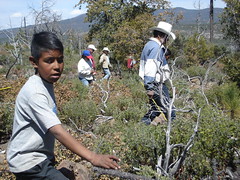
BY DAVID AGREN
The News
The federal government launched ProArbol amid much fanfare back in January 2007. Through this ambitious program, the country would replant hundreds of millions of trees, reverse environmental degradation and arrest rampant deforestation. ProArbol also promised to pull some of the country's most marginalized communities out of poverty.
But two years on, the program is under fire. ProArbol is plagued by corruption, poor planning and a dismal success rate, according to studies by Greenpeace México and recent investigations by the newspaper El Universal.
The recent scandalous headlines and allegations of mismanagement and failure are a strict departure from the praise given to President Felipe Calderón for his environmental initiatives in the past two years. He has won U.N. recognition for spearheading reforestation efforts and has been lauded for his initiative to help developing nations confront global warming. He has used ProArbol to further burnish those green credentials.
Still, while environmental activists, woodcutters' groups and opposition politicians offer damning criticism of ProArbol and the president's environmental record, others - forestry experts among them - are calling for patience before passing judgment. They still defend the program as a sincere attempt to overcome decades of neglect and mismanagement of the nation's forests.
"It's a program with good objectives," said José María Chávez Anaya, a forestry professor at the University of Guadalajara. "But we can't say that something is successful [or not] when it's only the first or second year."
Officials have largely remained silent in the face of the allegations, which broke in January. But Environment Secretary Juan Rafael Elvira Quesada, for one, has disputed many of Greenpeace's assessments.
ProArbol is more than just a reforestation program, he argues, as it includes conservation and anti-poverty objectives.
"It's been [called] a reforestation program, but that's not what it is. It's a general environmental protection program," he told El Universal recently. "It's a social development instrument that tries to preserve the environment."
'GREEN CORRUPTION'
The Greenpeace report on ProArbol's early results paint a grim picture. The group alleges that 90 percent of the more than 289.6 million trees planted in 2007 have already died. And some 56 percent of the trees planted under the auspices of ProArbol were actually not trees, but included species such as cactus, agave and maguey, Greenpeace says. The environmental group also alleges that species not native to Mexico have been planted.
El Universal - which titled one of its stories, "Green corruption in Chiapas" - profiled an impoverished village in the southern state, where local woodcutters said that ProArbol funds could not be accounted for. The federal Comptroller, the paper reported, had launched an investigation into the misappropriation of funds.
Politicians have since jumped on the issue, calling for an account from ProArbol administrators. They also revived longstanding allegations that the governing National Action Party is using the program - among other anti-poverty measures - to build up rural support bases.
"Support arrives in a partial manner . and isn't supporting the presented projects in a way that's transparent or uniform," Democratic Revolution Party Sen. Rubén Velázquez told The News.
Others in the forestry industry have their own gripes with ProArbol. Gustavo Sánchez, president of the Mexican Network of Campesino Forest Organizations, or Red Mocaf, believes the program has failed to live up to its promise and fails to offer enough new initiatives to those who make a living through small logging operations.
"What ProArbol does is take all of the resources that previously existed and put them all in one bag. It's presented as a new program, but in reality, it's a messy sum of programs that already existed," he said. "There are almost no new components [to] ProArbol . only the name."
Red Mocaf also alleges that groups who receive funding from Conafor have gotten preferential treatment from ProArbol - violating laws regarding government programs.
HISTORY OF FAILED EFFORTS
ProArbol is hardly the first federal attempt at reforestation and forest preservation. During the regime of then-President Porfirio Díaz in the early 1900s, Miguel Angel Quevedo founded the Viveros de Coyoacán, one of many nurseries that would produce millions of seedlings. Known as the "Tree Apostle," Quevedo later had small forests planted near railroad stations across the country and founded the Mexico Forest Society.
Later efforts have been described with less romanticism by forestry experts, who say that reforestation attempts over the past 50 years have been plagued by a lack of planning, little monitoring of reforested areas and the introduction of exotic species.
Federal enthusiasm for tree planting has also ebbed and flowed. In 1992, then-President Carlos Salinas launched "Forest Solidarity," which focused on urban and suburban forests. From 1998 to 2000, some 283 million trees - 70 percent of which were native species - were planted annually during the administration of Ernesto Zedillo, according to Julia Carabias, an UNAM biology professor and environment secretary at the time.
She argues that inconsistent government action is a key problem. "The lack of continuity in the reforestation programs has not permitted the consolidation of a true, long-term policy of environmental restoration," she wrote in a recent column in Reforma.
Indeed, deforestation continued unabated in the decades leading up to ProArbol's launch. Mexico ranks fifth in terms of annual deforestation, according to the United Nations, and loses an estimated 360,000 hectares of forested area each year due to illegal logging, development, forest fires and the felling of trees to make way for farms and ranches. Between 1976 and 1993, the country lost forested areas equivalent to the area of Guanajuato state, according to Chávez Anaya. By 2000, it had lost another forested area about the size of Campeche.
But experts attribute reforestation difficulties to factors that go beyond corruptions and ineptness. Restoration, they say, is complicated for various reasons.
For one, Mexico's forests boast incredible diversity. The landscape ranges from jungles and mangroves to hills covered with pines, cloud forests and even groves of maple trees. There are 170 kinds of oaks native to Mexico - the richest diversity of any country - said Dante Rodríguez Trejo, a forestry professor at the Universidad Autónoma Chapingo in Texcoco, State of Mexico.
"It's a very complex country," said the specialist in forest fires who has studied parts of the ProArbol program for the National Forest Commission, or Conafor.
ProArbol oversees the planting of 52 types of trees. Ninety-four percent of the seedlings are native species. ProArbol also oversees the planting of the many non-trees that are a point of contention with Greenpeace and are included in the program's reforestation numbers.
Rodríguez Trejo defended the planting of non-trees, saying that plants such as cactus, agave and maguey are ideal for arid parts of the country, help rebuild soil and prevent erosion and can be harvested for commercial purposes. "It's very important to have different plants for different situations," he said.
Many experts also laud ProArbol - as well as federal programs such as Zero Tolerance, which combats illegal logging - for attempting to preserve the country's forests as well as planting new trees. ProArbol equips and funds teams of rapid-response firefighters on ejidos, or communal properties, and indigenous communities.
In a study for Conafor, Rodríguez Trejo found that for every peso invested in the 288 rapid-response teams, the federal government saved 166 pesos, primarily in loss prevention. For every hectare charred by blazes, another 13.4 hectares were saved.
Still, Rodríguez Trejo expressed some caution over the fact that trees are being planted at such a blistering pace. "Although it's well-intentioned to plant a lot of trees, [it might be better] to plant less, [and] try to take better care of what's reforested," he said.
Defenders of the program like to cite a recently released study from the Colegio de Postgraduados in Texcoco, which found that the survival rate of trees planted through ProArbol in 2007 was 57.6 percent. Carabias noted the study in her column. "I consider ProArbol to be the best integrated program in forest management to come out of the public sector," she wrote.
FOREST FIGHT
On the ground, in the nation's wooded areas, critics of ProArbol and federal tree-planting efforts and forestry policies are making themselves heard.
Gina Uribe, a founder of the NGO Fuerza Ambiental, works on reforestation and creek bed restoration projects in Chihuahua. In the ejidos and small communities where she works, planning is often lacking, Uribe said. Planting sometimes occurs toward the end of the rainy season, giving the seedlings a diminished chance of survival; seedlings also arrive from Conafor nurseries located in desert regions - in other words, transplanted to different microclimates - which jeopardizes survival rates, she said.
Perhaps most disappointing for Uribe, the authorities "haven't managed to integrate the program into the communities."
Sánchez, of Red Mocaf, expressed similar frustrations. But, he acknowledged, "There were high expectations in the beginning."
His hopes faded as members of his group - which mainly represents small woodcutters and promotes sustainable forestry - began complaining of ProArbol shortcomings. Costs for transactions were high, they had to wait more than a year for the program to deliver payment for services rendered and getting anything done required wading through endless red tape. Some Red Mocaf members, Sánchez said, now prefer to enroll in agriculture programs, which can be more profitable and involve less bureaucracy.
And, like Uribe, he also finds fault with the lack of community integration on the part of ProArbol. "A problem is that [often] they're going to try reforestation in areas where people aren't sold on [the idea]," Sánchez said. "It's [often] not their plan. Someone from the government comes and wants to plant what they want, but [locals] don't have the time or money to take care of the trees. [Reforestation] works when it's in a community that already has a culture of forest management because [people] already know the benefits."
Some of ProArbol's anti-poverty objectives also bother Red Mocaf members. Sánchez said that changes in forest management policies - making permits easier to obtain, for instance - would do more to alleviate poverty. "In the medium term, if you develop a scheme of sustainable forest development, you're contributing to the reduction of poverty," he said.
'A TITANIC JOB'
It remains to be seen whether the outcry over the Greenpeace and El Universal report manage to fell ProArbol entirely. Attempts to obtain comment from Conafor, which oversees ProArbol, were unsuccessful.
Calderón still regularly highlights ProArbol as a pillar of his anti-poverty measures. And he has gained political mileage out of his administration's reforestation efforts. The United Nations Environment Programme recognized Calderón and the "Mexican people" on World Environment Day 2008 for showing "global leadership" and planting 250 million trees in 2007. Calderón himself even planted the 250 millionth tree - a rare blue pine - on Dec. 23, 2007.
Elvira Quesada, the environment secretary, vehemently denied that the program had any political ends and told El Universal it had been audited at least 100 times. He also acknowledged the enormous challenges that ProArbol faces. "In the reforestation process, we're restoring what we lost in past decades," he told the daily.
Optimistic experts like Rodríguez Trejo of the Universidad Autónoma Chapingo, too, are adamant that it is too early to write the program off.
"It's a titanic job. We still haven't offset commercial [logging] with reforestation and restoration, we still haven't offset the rate of deforestation that we have," he said. "In three years, there's going to be a completely different picture."

No comments:
Post a Comment